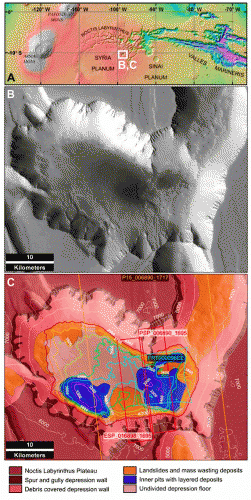If you could go to only one location on Mars, where would you find the most complete assortment of known Martian minerals? A new report, with lead author Patrick Thollot (Laboratoire de Planétologie et Géodynamique, CNRS), in the Journal of Geophysical Research provides an answer, but the information may not help mission planners much.

MARS MINERAL BOWL. One canyon intersection in Noctis Labyrinthus displays a remarkable variety of minerals, the greatest yet found in any one place on Mars. (Image taken from Figure 1 in the paper.)
The place to find the “most Mars minerals in a nutshell” (quoting from the paper’s title) is the bottom of a canyon intersection in Noctis Labyrinthus, a large network of valleys, canyons, and depressions just west of Valles Marineris. Noctis likely formed around 3.8 billion years ago, perhaps when volcanic heat from nearby Tharsis melted subsurface ice, and the water escaping through fractures led the surface to collapse.
The floor of this particular depression stretches about 20 by 40 kilometers (12 by 24 miles), and contains a stack of minerals several hundred meters (roughly a thousand feet) thick.
But the canyon bottom lies some 3,500 meters (11,000 feet) below the level of the surrounding plain, and its upper walls have slopes steeper and rougher than current Mars rovers can traverse. And while its floor appears mostly flat, the depression makes a target too cramped (and probably too windy) for present landing technology.
The researchers used mainly data from the CRISM, HiRISE, and HRSC instruments. Their goal in studying the minerals was to use them as a way to unlock the location’s aqueous history, investigating how deposits of water-altered minerals formed there. As they explain, “This site shows local formation of almost all classes of minerals identified thus far on Mars.”
Minerals include iron-bearing silicates, sulfates, and oxides, plus numerous varieties of clays and hydrated salts. Opal and hydrated volcanic glass are also present, along with hydrated sulfates.
The team reports, “The mineralogical history of Mars that has been inferred recently envisions an early wetter environment on Mars, either warm or cold, with permanent or transient liquid water on the surface, that favored the formation of phyllosilicates [clays].”
Then, they explain, the environment shifted toward increasingly arid and acidic conditions, more favorable to the formation of sulfates. “At the end of this purported climate change (3.5 to 3 billion years ago), the Martian environment would have become extremely arid, cold, and oxidative, and has remained so until today.”
For the minerals in the nutshell, the researchers suggest a sequence of chemical alterations including “the formation of acid sulfate solutions from groundwater and magmatic sulfur, which then locally altered the basaltic bedrock and layered sediments mainly deposited from volcanic tephra, forming iron-smectite and iron-sulfates.”









Pingback: Actualidad en Astronomía: Semana 21-5-2012 « Campos de Estrellas